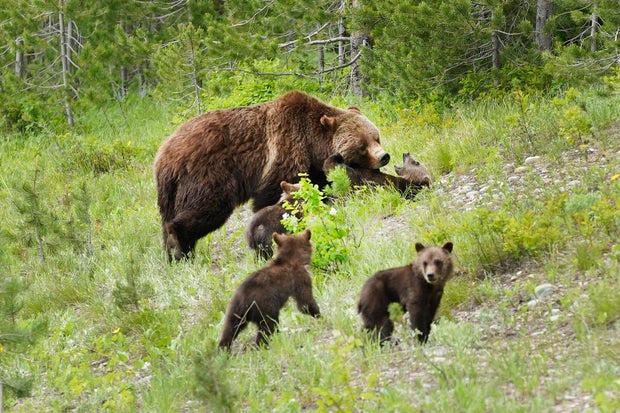A 5-year-old bear that was a member of a widely known and beloved grizzly household in Wyoming’s Grand Teton Nationwide Park died after it was hit by a car, the identical destiny that befell his mom late final 12 months, wildlife officers stated this week.
Park rangers discovered the physique of the male bear, often called Grizzly No. 1058, about 125 yards from Freeway 26 close to the Buffalo Fork River on Tuesday. The bear was considered one of 4 cubs that emerged in Might 2020 with their mom, Grizzly No. 399, who was usually referred to as the world’s most well-known grizzly bear.
Grizzly No. 399, who was beloved for many years by numerous vacationers, biologists {and professional} wildlife photographers, was hit and killed by a car in October on a freeway south of Jackson, Wyoming. Park officers used wildlife tags to substantiate the connection between the 2 bears.
Grizzly No. 1058 had been seen often within the park since he was weened in 2022, however no sightings of him had been reported this spring. After he was hit by the car, he made his approach to a patch of willows, the place he died, the Nationwide Park Service stated in an announcement.
Park officers stated Tuesday he might have been useless for a number of days earlier than his physique was discovered.
At 28 years previous, No. 399 was the oldest recognized reproducing feminine grizzly within the Yellowstone ecosystem. Every spring, wildlife fans eagerly awaited her emergence from her den to see what number of cubs she had birthed over the winter – then shortly shared the information on-line. The bear had 18 recognized cubs in eight litters through the years, together with the litter of 4 in 2020. She stood round 7 ft tall and weighed about 400 kilos.
Named for the id tag connected to her ear by researchers, the grizzly was usually seen close to roads in Grand Teton, drawing crowds and creating visitors jams.
The driving force who struck and killed No. 399 was not rushing, and the bear’s loss of life was dominated an accident. Park officers haven’t launched any further particulars in regards to the crash that killed No. 1058.

The Nationwide Park Service reminded guests this week that wildlife — together with bears, elk and moose — are “usually close to park roadways, troublesome to see, and may cross the street unexpectedly.” Officers stated drivers mustn’t velocity and be particularly vigilant in nationwide parks.
“Take note of your environment,” officers stated. “Rushing is just not the one reason behind wildlife collisions; park wildlife are sometimes hit as a result of drivers are distracted.”
Authorities stated 49 grizzly bears died due to car collisions between 2009 and 2023.
Grizzly bears typically dwell to be round 25, although some within the wild have lived for over 35 years, in response to the Fish & Wildlife Service.
Earlier than 1800, there have been an estimated 50,000 grizzly bears residing all through 18 western States, together with Wyoming, in response to the Fish and Wildlife Service. By 1975, the inhabitants within the 48 contiguous states was diminished to between 700 to 800.
After many years of being listed as threatened within the decrease 48 states below the U.S. Endangered Species Act, the inhabitants has grown to no less than 1,923 grizzly bears within the 48 contiguous states.
This article was first printed by CBS Information on 9 Might 2025.
Wildlife in catastrophic decline
The 73% decline in vertebrate wildlife populations over the past 50 years (mammals, birds, amphibians, reptiles and fish), is primarily pushed by human actions that threaten biodiversity.
Habitat Loss and Degradation – human actions like deforestation, urbanization, and agriculture have led to the destruction and fragmentation of pure habitats, lowering the house and sources accessible for wildlife.
Air pollution – air, water, and soil air pollution from industrial actions, agriculture, and different sources can hurt wildlife instantly or not directly by affecting their habitats and meals sources.
Local weather Change – altering climate patterns, rising temperatures, and sea ranges are disrupting ecosystems and impacting species’ skill to adapt and survive.
Overexploitation of Sources – unsustainable searching, fishing, and logging practices can result in the depletion of populations and the lack of biodiversity.
Invasive Species – the introduction of non-native species can disrupt ecosystems, compete with native species, and threaten their survival.
Assist to guard wildlife by donating as little as $5. Our conservation companions spend no less than 80 p.c of the cash raised on precise fieldwork reasonably than administration and fundraising.

